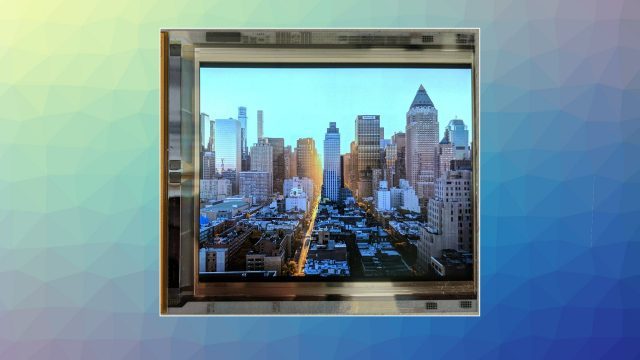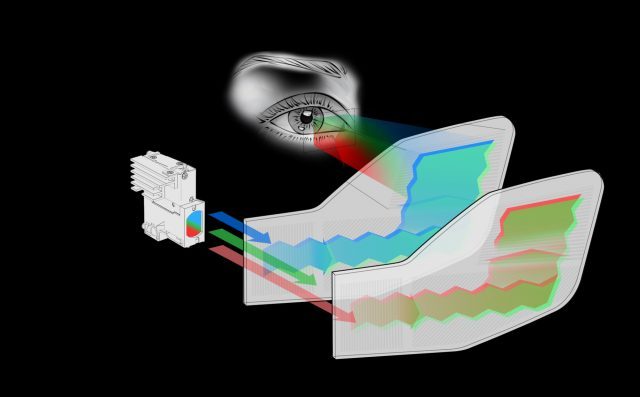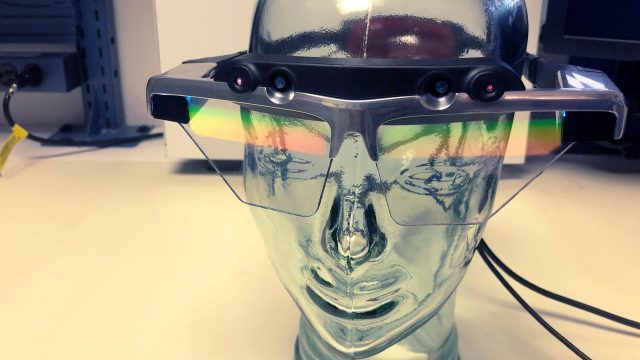Ultra Dense Displays

The resolution of today’s VR headsets might sound high on paper, but because the image is stretched across a wide field of view, resolution in today’s headsets is still significantly lacking compared to what you’d expect from a typical computer monitor, and even further from what the human eye is actually capable of. In most first-generation headsets it’s easy to see aliasing and the ‘screen door effect’—a grid-like artifact that’s caused by the unlit space between pixels. With enough resolution, VR headsets could eliminate both issues completely.
Display companies are racing to create ultra dense displays which are also inexpensive enough to go inside consumer VR headsets. In the last few months alone Samsung showed that it was developing a 3,840 × 2,160 VR display with 1,200 pixels per inch. Meanwhile, Google & LG revealed a 4,800 × 3,840 display with 1,443 pixels per inch. And then there’s INT who is promising a display for VR headsets with a staggering 2,228 pixels per inch.
Varjo Retina Resolution Headset

Ultra dense displays may not be here just yet, but Varjo has created a promising shortcut to achieving retina resolution in a VR headset by using a combination of macrodisplays and microdisplays to put high density resolution at the center of your view without giving up a wide field of view.
While most VR headsets today use one display per eye, Varjo’s ‘Bionic Display’ headset actually uses two. The first display offers a fairly standard resolution compared to today’s traditional headsets, but the second display is a pixel-dense microdisplay offering 60 pixels per degree. The image from the second display is projected directly in the center of the first display, putting the pixels smack dab in the place where your eye sees the most detail.
The result is pretty impressive: a headset which has an immersive field of view, but also retina resolution at its center where you can’t see any pixels or screen door effect. Of course, the peripheral area is standard resolution so if you turn your eye you’ll lose the benefits of the high res display, but that’s a small tradeoff for the opportunity to see retina resolution in a VR headset today, instead of years down the road. The company is also investigating methods for moving the high res display using eye-tracking input so that you see the maximum quality no matter where you look.
Varjo is targeting enterprise use-cases with its Bionic Display headset, but the company has largely proven a novel display design which could find its way into consumer headsets in the near future.
DigiLens 150 Degree Waveguide

AR headsets today can be made fairly small, but generally have a small field of view to match. While ‘bird bath’ style optics (like those in Meta or Project North Star) offer a large field of view, they are necessarily quite bulky. It will take a different approach to achieve the ultimate vision of AR—a device offering an immersive field of view in a truly glasses-sized device that can be worn all day.
DigiLens, a developer of transparent waveguide display technology, says it’s working toward a waveguide display which could bring a 150 degree field of view to AR headsets in a truly glasses-sized form factor. The company’s approach involves ‘printing’ light manipulating structures into thin and transparent material wherein light can be guided along the optic and be made to project perpendicularly, forming an image in the user’s eye. With such precise manipulation of light, the optic effectively acts as both the lens and the display, opening the door to significantly more compact optical designs than what’s found in most AR headsets today.

What’s more, DigiLens says that the tech could be paired with a light blocker or even a liquid crystal blackout layer (to make the optic opaque), enabling a single compact headset to be capable of both immersive AR and VR.
DigiLens has already developed a AR reference headset with a 50 degree field of view across both eyes. Using a technique combining multiple layers of the optic for a wider field of view, the company expects to be able to achieve a 150 degree field of view in 2019.






